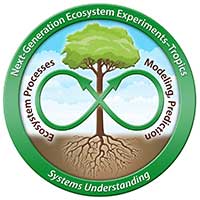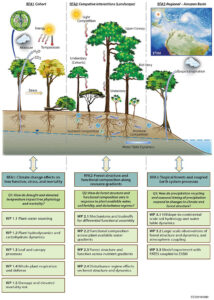Advancing predictive understanding of tropical forest responses to global changes across scales
Project website | Overview brochure PDF
Principal investigator: Jeffrey Chambers
Tropical forests cover less than 7% of Earth’s surface but cycle more carbon, water, and energy than any other biome. These forest-atmosphere exchanges play a major role in regulating Earth’s climate. However, tropical forests are currently experiencing rapid changes with increasing temperature, intensifying drought, rising atmospheric carbon dioxide (CO2) concentration, and anthropogenic land use. Tropical forests are responding to these changes, and feedbacks from these responses impact carbon, energy, and water cycling both regionally and globally. Understanding these responses and feedbacks and protecting the major role that these forests will have on future Earth system dynamics requires comprehensive and accurate representation of tropical forests in Earth system models (ESMs).

Canopy Lift in Amazon. Daisy Souza, an NGEE Tropics team member at the National Institute for Amazon Research, works on the canopy lift in the Amazon, Brazil. [Courtesy Bruno Gimenez]
Currently, the structure and function of tropical forests are poorly represented by ESMs, so scientific understanding of how tropical forests will impact global processes is highly uncertain. ESMs are missing key biogeochemical and ecological dynamics that are poorly validated by observations, and key forest structural properties are not accurately represented. Substantial improvements in model structure, parameterization, and evaluation, using experiments and observations, are thus required to capture the important roles tropical forests play in the Earth system.
Supporting DOE’s Energy Exascale Earth System Model
In support of the mission of the Department of Energy’s (DOE) Biological and Environmental Research (BER) program to advance a predictive understanding of complex biological, Earth, and environmental systems, the overarching goal of the Next-Generation Ecosystem Experiments project in the Tropics (NGEE Tropics) is to develop a greatly improved predictive understanding of tropical forests and Earth system feedbacks to changing environmental drivers. To attain this goal, NGEE Tropics will deliver a state-of-the- art, process-rich tropical forest ecosystem model that accurately represents forest structure and function and provides robust projections of tropical forest responses to global change. The first version of this model—the Functionally Assembled Terrestrial Ecosystem Simulator (FATES)—was developed and coupled to DOE’s Energy Exascale Earth System Model (E3SM) in Phase 1 of NGEE Tropics. Work in Phase 2 develops and evaluates FATES, a next-generation dynamic global vegetation model that represents forest demography and ecophysiology and explicitly simulates competition among trees of different sizes and functional types.

Amazon Forest Tower. Canopy tower from the floor of the Amazon Forest, Manaus, Brazil. [Courtesy Charles Koven]
Measurements to Inform Models
A strong coupling of model development and evaluation with experiments and observations underpins E3SM-FATES’s fundamental approach to advance scientific understanding and model representation of tropical forests. This deliberate and focused integration of models and experiments—known as the ModEx research approach—ensures that model development is informed by the latest empirical knowledge and that field measurements are explicitly designed to target gaps in process understanding or parameterization, thereby addressing substantial uncertainty in E3SM-FATES. To evaluate model performance at individual, community, and regional scales, this approach requires the development of model testbeds, which couple models with site-specific meteorological and plant trait data and drive integration with other observations for model testing.
Phase 2 Approach
Phase 2 is structured around three Research Focus Areas (RFAs) designed to advance understanding and model representation of processes at individual (RFA1), community to regional (RFA2), and regional and global (RFA3) scales in E3SM-FATES. The science within these RFAs is organized into ModEx Work Packages (WP). Each WP is tightly coupled to existing model code within E3SMFATES or focused on developing new process representation in the model. The WPs within each RFA are coordinated to enable delivery of RFA-level goals for FATES development and evaluation. As the unifying platform at the center of this organizational structure, E3SM-FATES integrates scientific advances across all three RFAs and ultimately enables the NGEE Tropics team to address key science questions. Moreover, this RFA and WP structure along with a comprehensive ModEx approach facilitate scientific hypotheses testing and uncertainty reduction in emergent model outcomes for RFA Science Questions (Qs). The three RFAs and associated Qs are briefly described below.
From Individual, to Community, to Regional Scales
RFA1: Climate change effects on tree function, stress response, and mortality.
Q1: How do drought and elevated temperature impact tree physiology and mortality?
Phase 2 research focuses on water sourcing, hydrodynamics, leaf and canopy CO2 and water exchange, carbon storage, plant respiration, defense, and damage associated with elevated mortality risks occurring at the individual (cohort) level. RFA1 provides new understanding and model representation that will enable FATES to more accurately predict functional responses, stress, and tree mortality under drought and elevated temperature.
RFA2: Forest structure and functional composition along environmental gradients.
Q2: How do forest structure and functional composition vary in response to plant available water, soil fertility, and disturbance regimes?
Representation of tropical forest community structure and functional composition, and how they mediate Earth system–scale responses to climate forcing and disturbance, are key innovations that FATES provides to E3SM. Phase 2 focuses on developing accurate representation of forest structure and functional diversity along water-availability, nutrient-availability, and disturbance gradients to enable reliable projections of forest-climate system interactions under global change scenarios. RFA2 developed a new nutrient-enabled version of FATES, allowing forest functional assembly to vary with competitive interactions for limiting nutrients.
RFA3: Tropical forests and coupled Earth system processes.
Q3: How do precipitation recycling and the seasonal timing of precipitation respond to changes in climate and forest structure?
Precipitation recycling and seasonal timing are tightly coupled to changes in climate and forest structure and play out across spatial scales from hillslopes to continents and along regional environmental gradients that include both natural and anthropogenic disturbance. Work in RFA3 requires an informed coupling of FATES with E3SM soil hydrology, development of new data products to serve as model benchmarks, and fully coupled E3SM-FATES interactions at regional and global scales.
Work in each RFA builds mechanistic, foundational understanding to be incorporated into process representation at progressively larger scales up to a next-generation ESM grid cell. Process advances in RFA1 enable functional assembly in RFA2 to emerge mechanistically, providing more accurate projections of how vegetation structure and function respond to a changing climate. RFA1 processes and RFA2 functional assembly integrate with regional soil hydrology (RFA3) and enable fully coupled evaluations of E3SM-FATES in RFA3.
A Global Model with a Pantropical Perspective
NGEE Tropics takes a pantropical perspective using new research and data from across the globe with a diverse team and strong international collaborations. Researchers and collaborators conduct intensive research activities for Phase 2 at three primary locations: Puerto Rico, Panama, and the Amazon Basin. These will be supplemented with several additional pantropical sites with essential data, including globally distributed forest dynamics plots. Site selection balances scientific needs with logistical and infrastructural requirements. To maximize research impact, NGEE Tropics publicly shares model code and data following data and software policy. Phase 2 advances in FATES and ModEx will provide greatly improved projections of vegetation dynamics in the next generation of E3SM.

